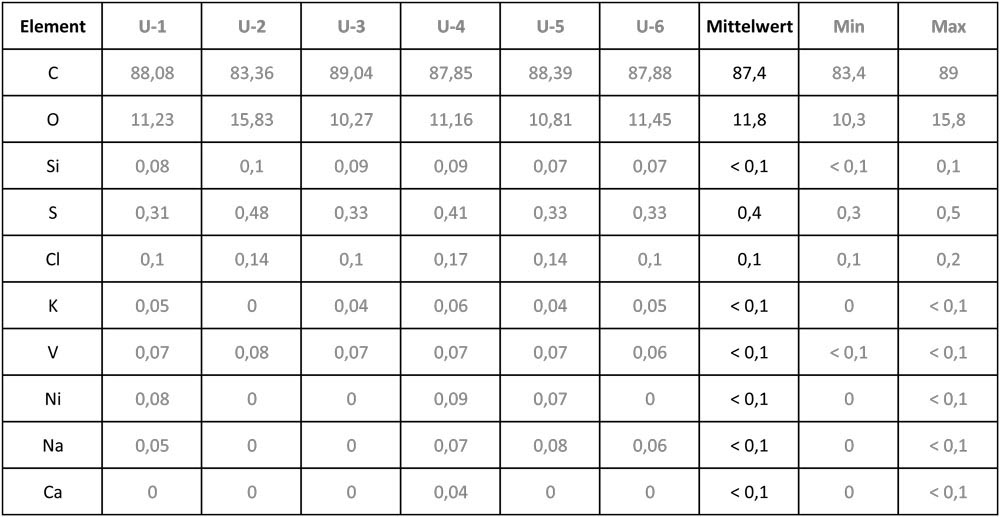Vielen Dank für Ihr Interesse am unserem Newsletter!
Schauen Sie in Ihre Mailbox. Um die Anmeldung abzuschließen, müssen Sie die Bestätigungsmail beantworten oder dem darin enthaltenen Weblink folgen.
Chemical composition of shungite rock.
To determine the chemical composition of shungite and obtain clarity regarding the carbon content (about which there is a vast amount of different information), we ordered a scientific study at the Kharkiv Institute of Physics and Technology (NSC KIPT). We would like to present a summary of the results below.
Method:
The phase composition of the shungite rock has been studied using infrared spectroscopy and optical analysis of crystals. The study was carried out on a certified UR-20 IR spectrophotometer.
Two types of shungite were studied individually since the composition of the stones is different.
The results of the study give an idea of the chemical composition of the shungite rock. Please, do not regard the results of the research as proof or denial of the effect of shungite. In this case, the percentage of one or another chemical element does not say anything about the effect of the stone.
Research process:
The rock samples for the research came from our warehouse and are exactly identical to the stones that we offer our customers. These are elite shungite from the vicinity of the village of Shunga and classical shungite from the Zazhoginsky mine.
Elite shungite (Category 1)
Elite shungite is a stone that naturally contains various mineral components. Compared to classical shungite, inclusions are distributed relatively evenly. It can also be seen in the microscope when the surface is magnified as presented on Figures 1, 2 and 3.

Figure 1 (surface of elite shungite, 500x magnification)

Figure 2 (surface of elite shungite, 200x magnification)

Figure 3 (surface of elite shungite, 20,000x magnification)
Several studies were carried out in different areas of the rock sample to determine the composition of elite shungite. We also used molecular spectroscopy on the surface of elite shungite, where orange or transparent spots were found.

Picture 4 (transparent orange spot on the surface of elite shungite, 500x magnification)
The study was conducted at six different sites (U-1 to U-6) to determine the actual mean values. The table below provides an exact list of chemical elements.

Table 1.
The carbon content in elite shungite is 87.4%.
The main component of elite shungite is carbon (C) with the average content of 87.4%. Classical shungite is significantly different in that regard. This study was unable to determine if carbon is in the form of fullerenes.
The high oxygen content of about 11.8% is evidence of the fact that some elements in shungite occur as oxides.
As can be seen from the table, other elements are present in shungite only in very small quantities.
Classical shungite (Category 2)
Classical shungite is a composite rock. Therefore, it naturally contains many different mineral components in varying amounts, and these components are unevenly distributed. Even the surface of a rock sample is very different when viewed in a microscope, as seen in Figures 5, 6 and 7.

Figure 5 (surface of classical shungite, 500x magnification)

Figure 6 (surface of classical shungite, 250x magnification)

Figure 7 (surface of classical shungite, 200x magnification)
Several analyses were carried out at different sites on the rock sample to determine the actual composition of the stone. Molecular spectroscopy was also used there. In Figure 8, you can see the schematics of two analyses. Curve 1 shows the results for the dark area of the rock sample (Figure 5), while Curve 2 shows the results for an area mainly composed of pyrite and quartzite (Figure 6 and 7) that looks greyish or gold on the stone surface.

Figure 8
Table 2 contains the results of the three analyses mentioned above. Table row 1 shows the results for the dark area (see Figure 6) of the sample. More than 90% of the total mass of the rock sample consists of material from this dark area. Therefore, the values determined here are critical for the average value, which is given in Table 3.
The lighter and greyer areas are composed of lighter quartzite and/or pyrite.

Table 2
Seven more areas (U-1 to U-7) were examined on the rock sample to determine the actual average values.

Table 3
The carbon content in classical shungite is 51.9%.
The average content of carbon is lower in classical shungite and comprises about 51.9%. However, this does not mean that classical shungite is worse. Both types of shungite with their unique composition have their advantages and disadvantages in their application.